A crossover network, a vital part found in virtually every loudspeaker on the market, directs different frequencies to the appropriate driver. This ensures that you obtain optimal sound quality from your speakers.
Crossover frequencies also come with settings to allow individuals to customize the sound. To understand how frequency settings work, you may want first to familiarize yourself with a crossover’s basics.
This article will equip you with:
- The functioning of a crossover
- Frequency settings for different speaker types
Ready? Then read on to learn more!
What is a speaker crossover?
Definition
The term “crossover” gets thrown around a lot in the audio community. Crossovers are electronic devices that essentially act as a filter for frequencies. Also, they divide a single unfiltered audio input signal into two or three audio signals. These signals are divided based on some predefined upper and lower thresholds of the frequency range. Then, the crossover will send frequency/signal ranges to the driver designed to reproduce that signal as sound best.
How a speaker crossover works
When the electric signal travels from the speaker wires to the speakers, it passes through the crossover units for each driver.
A speaker crossover is an electric circuit made up of different electric components. These components work together to separate the dissimilar ranges in the audio spectrum, sending signals to specific drivers and speakers.
The most important components to remember are inductors and capacitors. Inductors and capacitors filter the audio signals, spitting them among two or more outputs.
Let’s take a look at the properties of inductors and capacitors.
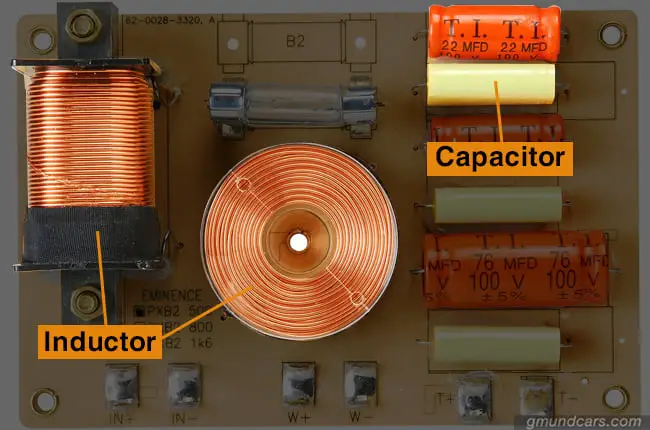
- Capacitor: show more “resistance” to a low-frequency signal than a higher one. So, the lower the frequency, the lesser the chance of the frequency passing through the capacitor.
To reach the tweeter, the signal will have to pass through the capacitor. If a signal is applied to the capacitor that is way past the crossover frequency range, resistance will increase. So, the tweeter will only receive high-frequency signals because the capacitor is resisting other signals. - Inductor: is the coil of wire that shows more “resistance” to a high-frequency signal than a lower one. As a result, it only acts as a good conductor for low-frequency sounds and filters out high frequencies.
Similar functionality is applied to the inductors. The inductor will only respond to low frequencies and send these frequency signals to the woofer. The signal will pass through both inductor and capacitor to set an upper and lower cut-off point for mid-range drivers.
How does a speaker crossover affect the sound?
Sending the accurate frequency responses to the specific drivers
The frequencies are divided into high, low, and mid-range frequencies. The speaker crossover is responsible for clarifying and sending frequencies to the right drivers or speakers. For instance, tweeters are designed to reproduce high frequencies. A speaker crossover will ensure that tweeters only receive the highest of frequency signals, nothing lower.
As you can tell by now, crossovers are essential for accurate frequency response. Without it, frequencies will not be directed correctly, and speakers will play inappropriate sounds. This would significantly reduce the potential of a speaker’s performance.
Avoiding the resonant frequencies
The resonant frequency can make the specific sounds to be reproduced with the distortion. The crossovers protect speakers from reaching their resonant frequencies. Moreover, the speaker crossover can also eliminate the vibrations made from the frequencies of the enclosure surrounding or drivers.
Passive vs. Active crossover
The classification of crossovers can be done based on the types of components they use. There are mainly four categories of crossovers that differ in their parts. However, passive and active crossover are the most common of this kinds of classification. Below comes with the major differences between the passive and active crossover:
| Passive | Active | |
|---|---|---|
| Wired | Between amplifier and the speaker | Between the receiver and the amplifier |
| Function | Spliting up an already amplified audio signal, sending the signal to two or more drivers. It works exceptionally well in transitioning the audio from tweeter to mid-range sounds | Operating with low-level audio signals suited for powering amplifier inputs. It divides the frequency bands using the line-level signals |
| Sound | Lesser quality and accuracy | High-quality music |
| Price | Inexpensive | Expensive |
Passive crossover
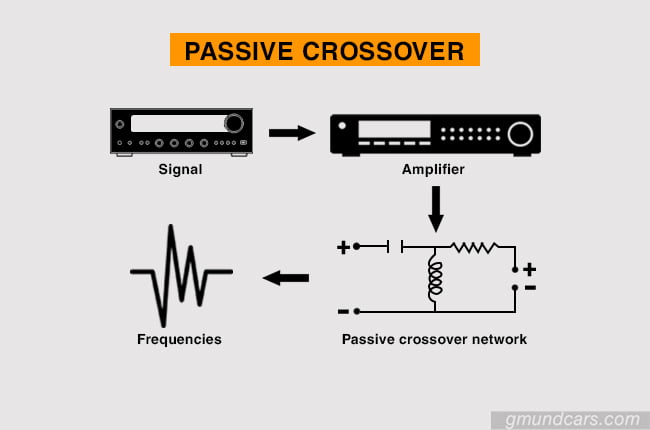
This crossover type mostly uses passive filters in combination with resistors, capacitors, and conductors. Some modern passive crossovers will include fuses or circuit breakers to safeguard the speaker drivers against sudden spikes in power.
The passive crossover splits up an already amplified audio signal, sending the signal to two or more drivers. It works exceptionally well in transitioning the audio from tweeter to mid-range sounds.
One of the reasons why people go for passive crossovers is because they are inexpensive. They are less expensive to produce than, say, active crossovers. However, they offer audiophiles minimal control over the volume of each frequency band.
The sound produced from such crossovers will be of lesser quality and accuracy. You can get high-performing passive crossovers, but these are more expensive than active crossovers. That’s because the components are capable of good audio performance at a high current and voltage level.

Audiopipe CRX-203 Car Audio Passive Crossover
Active crossover
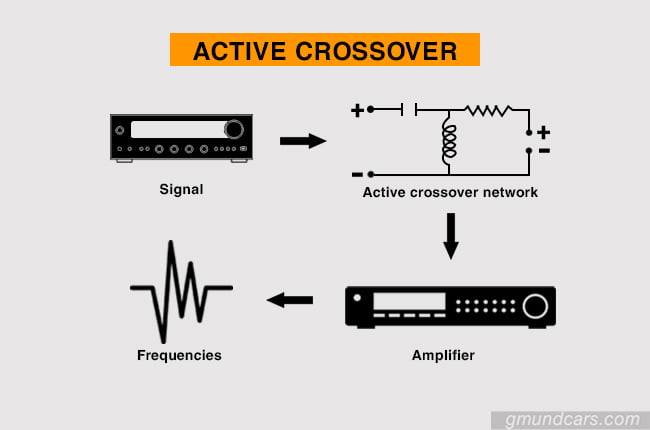
Unlike a passive crossover, an active crossover reproduces audio signals with active components instead of passive ones. It combines operation amplifiers (op-amps), resistors, and capacitors to filter different frequency ranges.
An active crossover requires an additional external power source to function so that every driver has its own amplifier. This allows every amplifier to have greater control over each driver.
It also means that there is more separation between the speaker drivers that reduces distortion. For instance, if one of the amplifier channels begins to clip, this will only affect a single driver’s quality.
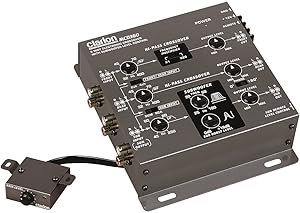
Clarion MCD360 Electronic Crossover
An active crossover is usually a popular choice for those who prioritize sound quality with all its features. You have control over the volume of each frequency band. Furthermore, you can control the amplifiers, so they only focus on frequencies you want to boost.
It may be more expensive than a regular passive crossover. However, the control options let you fine-tune the audio so you can enjoy high-quality music.
2 way vs. 3 way vs. 4 way crossover
Another way to clarify 2 way, 3 way and n-way crossover is the number of filter sections which they include. Listed below are the three types of filters you will find in a crossover network.
- Low-pass filter (LPF): This filter is also known as a high-cut filter. It only allows frequencies below the crossover cut-off point. So, it imposes a ceiling to cut out any high frequencies.
- Band-pass filter (BPF): A band-pass filter is considered to be a combination of a low-pass and high-pass filter. It only allows a particular frequency range. This occurs by filtering frequencies above the high point of the range and frequencies below the low point.
- High-pass filter (HPF): You can refer to a high-pass filter as a low-cut filter as well. Only frequencies above the cut-off point can pass through this filter. Instead of a ceiling, a high-pass filter sets a “floor” to cut off any too low frequency.
2 way crossover
A 2-way speaker crossover will divide the frequency range between two speakers. Speaker systems include these crossover networks with two drivers – a tweeter and woofer. High frequencies are sent to the tweeter through HPF, and the low frequencies are sent to the woofer through LPF.
3 way crossover
A 3-way speaker crossover will include three filter sections with HPF, BPF, and LPF. 3-way speakers rely on such a crossover design to divide the frequencies into low, mid, and high-range. Mid-range frequencies are sent in the direction of the mid-range speakers.
4 way crossover
A 4-way speaker relies on a 4-way crossover to send signals to 4 drivers. These drivers are typically a woofer, a mid-range speaker, a tweeter, and a super tweeter. The sound frequencies are reproduced as lows, mids/low-mids, highs/high-mids, and highs/super-highs.
If the 4-way speaker has a super tweeter, the extra filter will only allow ultra-high frequencies to pass through.
N-way crossover
“N-way” crossovers will either have an extra HPF or LPF section. The additional HPF section in the crossover will protect the low-frequency drivers from frequencies, which are lower than they can handle. If the crossover has an extra LPF section, it can defend high-frequency drivers against damage by extremely high frequencies.
Modern manufacturers have also introduced “N.5-way” crossovers. “N.5-way” crossovers come with an extra filter section for a second woofer. While it does play the same bass range as the main woofer, the second woofer bass sound rolls off quicker.
Parallel vs. Series crossover
Parallel
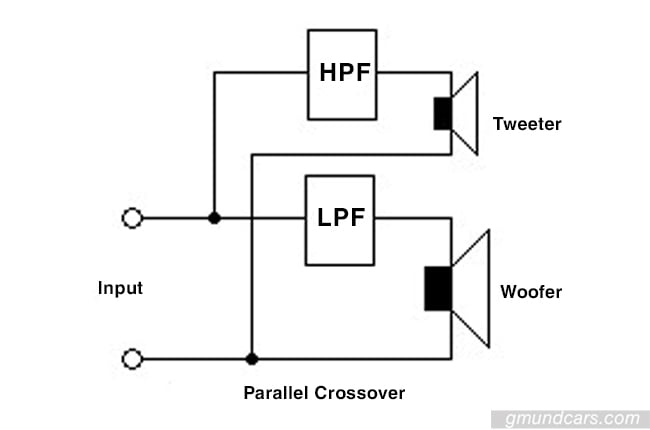
This is the most common type of crossover. In this type, all the filters are fixed parallel to each other. So, they do not come in contact with each other and never interact. Most of two-way crossovers use these parallel crossover networks.
When they are placed parallel to each other, they can be treated as separate entities. Additionally, because of the impedance, they are also isolated elements. However, the entire competence of this circuit depends on the compatibility of the drivers.
Another popular reason why these filters are common is their bi-wired feature. They allow speaker wires to be bi-wired which is very uncommon in other types of circuits.
Series
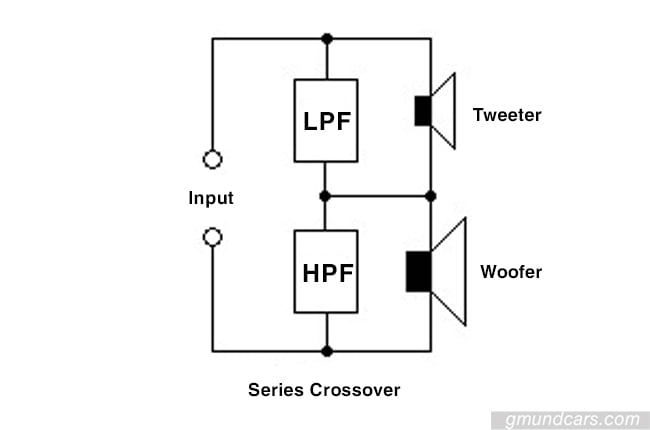
Filters in this type of circuit are connected in series, whereas drivers are in parallel. These driver combinations are in series with each circuit’s filters, making it seem a little more complicated.
In this type of circuit, the high-frequency signal on the upper input terminal has a slightly positive voltage than the lower input terminal. The signal passes through the tweeter because of its low impedance.
Then this signal reaches the point of connection between the woofer and high pass filter. In this situation, the high pass filter has a low impedance, so the signal goes through it. At the LPF, a low-frequency signal is observed first, which goes onto the woofer and finally the lower input terminal.
First-order vs. Second-order vs. Third-order crossover
Speaker crossovers can be classified based on their slope. The most common types of crossovers seen are the first, second, third, or fourth-order type.
Here are the different types of crossovers segregated based on their order, including high-order electric filters.
| Feature | Characteristic | Octave slope | |
|---|---|---|---|
| First-order | Having a flat power response to be considered an all-pass crossover (APC) and constant-power crossover (CPC) network | Butterworth | 6dB |
| Second-order | Providing a better balance between complexity, high-frequency driver protection, and response | Bessel, Butterworth, Linkwitz-Riley | 12dB |
| Third-order | Creating an off-axis response that is symmetric with the help of the symmetric driver arrangement | Butterworth | 18dB |
| Fourth-order | Reducing the modulation distortion to the maximum | Butterworth, Gaussian, Legendre, Linear-phase, and Linkwitz-Riley | 24dB |
First-order
This type of filter has a 6 dB octave slope or a 20 dB decade. Many people consider this type of slope to be perfect for their vehicles. This is because it comes packed with features that are easy to understand and ideal for optimum sound quality.
Every first-order filter comes with the Butterworth filter characteristic. This is one of the top advantages of these filters. The feature enables minimum phase response along with a flat amplitude response making it ‘transient perfect.’
This crossover filter has a flat power response as an all-pass crossover (APC) and constant-power crossover (CPC) network. This is a two-way split which is highly popular. It comes with a 90-degree phase shift which gives you a tilt of -15 degrees.
First-order filters are not suitable for three-way crossovers. While the most ideal for perfect audio, these filters do not provide proper separation because of their shallow 6 dB octave slope.
Second-order
Unlike the first-order filters, all second-order filters are not Butterworth. They can have Bessel, Butterworth, or Linkwitz-Riley characteristics. This entirely depends on their design and build. This type of filter has a 12 dB octave slope considered much more efficient than the first-order filters.
One of the best features of this type of filter is that it provides a better balance between complexity, high-frequency driver protection, and response. The phase difference of 180 degrees can result in the low-pass filter and the high-pass filter having a similar frequency. This is one reason why the high-frequency driver is connected to the output in an inverted state.
Third-order
With the classic Butterworth filter characteristics, third-order filters are another common crossover type. They come with a 60 dB decade or 18 dB octave slope, which makes them great at phase response.
This feature could be credited to the flat output similar to first-order crossovers. Their polarity is unique and generally has an asymmetric response. This type of filter is usually made from first- or second-order filter circuits. The third-order crossovers create an off-axis response that is symmetric with the symmetric driver arrangement.
Fourth-order
This filter is a little more complex than the ones above. It has an 80 dB decade or 24 dB octave slope. Their design in passive types is a little more advanced. This is because of the way all the parts of the filter interact with each other.
Individual components are very intricate, and it cannot be easy to configure this device manually. However, over the years, the use of design software has made it very easy to achieve accuracy in these designs.
It can be of any type from Butterworth, Gaussian, Legendre, Linear-phase, and Linkwitz-Riley, even though this type of filter reduces the modulation distortion to the maximum.
Higher and mixed order
Higher-order filters are costly and complicated to build. This is the main reason why it is rare to find these filters. Higher-order filters can have about 96 dB octave. This allows them to be components in loudspeaker management systems very easily.
On the other hand, you can craft mixed-order filters. You can combine a third-order filter with a second-order filter and use the final product. These filters usually are passive. However, this is generally the case when computer program optimization finds values of the components.
Crossover frequency setting
What is crossover frequency
The crossover frequency is also termed cutoff frequency or corner frequency. The sound frequencies post this point will be cut more and more.
On the other hand, the crossover frequency is the sound frequency point, which specific sounds will be blocked or reduced. With this crossover frequency point, the signals will be reduced by 3 decibels.
In simpler terms, your speakers will not hit the range of sound starting at the crossover frequency.
Crossover frequency setting chart
Trust me! There is no best frequency setting for your audio system because it depends on several things. The recommendations mentioned below are just a suggestion. You are free to set the frequency anywhere you please and wherever you feel the audio sounds best!
| Components | Recommended frequency | Notes |
|---|---|---|
| Subwoofer | 70 Hz - 80 Hz (low pass) | Subwoofers are usually utilized for their strong bass and powerful audio output. If you want to hear a clear bass sound with minimum midrange disturbances, the low pass frequency is ideal for this type of speaker! |
| Full range speaker | 56 Hz - 60 Hz (high pass) | If you want to settle between high and midrange audio quality, go for this number |
| Tweeters (2way speaker) | 3 kHz - 3.5 kHZ (high-pass or high/low-pass) | Tweeters are notorious for having particular frequency requirements. Most of them cannot handle frequencies below this number |
| Midrange/Woofer | 1 kHz - 3.5 kHz (low pass) | They are not suitable for treble and work well with a low pass frequency only |
| Woofer/Tweeters (3way speaker) | 500 Hz - 3.5 kHz | Below the 500 Hz frequency the audio might be compromised. This type of speaker works best with an upper frequency |
How to set the crossover frequency
If you fail to set the crossover frequency, the subwoofer will not offer deep bass or low-frequency notes. In case you have an integrated system with the modern EQ feature, the crossover frequency will already be automatically set.
In the present day, most speaker systems have an automatic crossover frequency process. However, if your sound system is conventional, you need to set it manually. Here’s a step-by-step guide to manually set the crossover frequency.
Step 1: Determining the suitable crossover frequency
Firstly, the crossover frequency for each element on your sound system is different. The suitable crossover frequency for subwoofers is around 80Hz. This crossover frequency is perfect for low-end bass. Similarly, the frequency range is diverse for all the other systems.
The crossover frequency for your system should be such that it can filter any unwanted sound. Honestly, it is a tad challenging to settle on a specific crossover frequency for all the speakers. However, there are come standard frequency ranges that might work in every case.
Step 2: Figuring out the low-end
The second step in the process is the figure out the low-end of your subwoofer’s frequency range. Generally, you can find the low-end frequency of the subwoofer from the user manual. You can also hop on the manufacturer’s website to understand the low-end frequency.
Step 3: Setting crossover point
The next step is to set the crossover point. It’s ideal to set the crossover point almost 10 Hz higher than the manufacturer’s recommended range. This strategy will offer you the best results with your sound system. You can also go with the recommended 80 Hz range if you prefer.
You may also use an online subwoofer matching tool for this process.
Step 4: Testing!
Now that you’ve set the crossover frequency point, it’s time to check them. You must hear the sound for a smooth transition. The transition between the rest of the speakers and your subwoofer should be crispy and flowy.
All the sounds from the sound system should be in unison. The target here is to achieve a natural blend between the sound system. In case you notice a bass bump at the crossover frequency point, you have to make some adjustments. Regulate the subwoofer volume to blend and match with the audio from the rest of the sound system.
To conclude with
You will be surprised to know that almost all the speakers you have in your car have a crossover network. This is important because, without it, the frequency will never reach the right driver adequately. So, with all this knowledge, you should have no trouble setting up crossovers for your car and making your automobile audio system top-notch!
FAQs:
1. What should I set my High-pass filter (HPF) and Low-pass filter (LPF) to?
This entirely depends on the kind of speakers you will be handling. Ideally, it is expected that you set the HPF of your crossover with a steep slope. This steep slope could be anywhere around 24 dB octave or more.
This is done because steep slopes are usually used in protecting your subwoofers. Similarly, your LPF should be set anywhere around 12 dB octave. This will help you balance out the mids in the audio too.
2. Does a full-range speaker need a crossover?
No, you don’t need to use a crossover for a full-range speaker. This is because crossovers are used to provide the right audio output for different speakers in the same car.
3. How do I know if my speaker crossover is terrible?
If you have a passive crossover, then it is likely to blowout once it has gone bad. Your tweeter, for instance, will stop producing any sound, and it will only have mid audio.
All you need to do is turn up the music while you check the A/C voltage. If the voltage on your crossover is 0, it hasn’t gone well. However, this will only work in the case of an active system.
4. What is the difference between a crossover and an equalizer?
A crossover is used to adjust the frequencies supplied to the various speakers in your car. On the other hand, an equalizer boosts or cuts the frequency on the whole. It manages the frequency output in your audio system.
